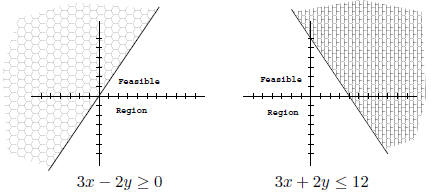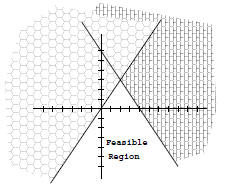|
Home |
InequalitiesSection 3.2 Linear Programing Problems. Be sure that you define your variables as shown in class. I
am very picky about this and will deduct points Word Problems for Section 3.2 Set up the following linear programing problems. Do not solve. 1. A 4-H member raises only geese and pigs. She wants to
raise no more than 16 animals, including no 2. The Hi-Fi Record Store is about to place an order for
cassette tapes and compact disks. The distributor 3. The Acrosonic Company manufactures a model G
loudspeaker system in plants I and II. The output Section 3.1 Inequalities • Note: if you multiply or divide an inequality by a negative number, then you must flip the sign. • The feasible region is the set of points that satisfy
the system of inequalities, i.e. makes the inequal- • When graphing inequalities use a solid line for ≥ or ≤ and use a dashed line for < or >. • There are two methods for nding feasible regions. One
method is to shade the feasible region. This • To nd the feasible region (of a single inequality): 1. Graph the line represented by the inequality: solid line for ≥ or ≤ and dashed line for < or >. 2. Pick a point from one side of the inequality and plug
the point into the inequality. Be sure that 3. If the point makes the inequality true, then scratch o
the side that did not contain the point 4. The side of the inequality that is not scratched o is
the feasible region. Label it with: Feasible Example 1: Here are feasible regions for the inequalities 3x − 2y ≥ 0 and 3x + 2y ≤ 12.
If your system of inequalities has more than one
inequality, then the feasible region is the part of the Example 2: Here is the feasible region for the system of inequalities: 3x − 2y ≥ 0 and 3x + 2y ≤ 12.
• Shading with the Calculator. First solve the inequality
for y. Remember if you multiply or divide • A feasible region is bounded (fenced in) if it can be enclosed by a circle. Otherwise it is unbounded. Section 3.3 Method of Corners. • A corner point is a point on the edge of the feasible
region where two inequalities in the system of • Theorem: Given a feasible region, called R, and an objective function f = ax + by - If the objective function has a maximum or a minimum
then it will happen at a corner point. • If the feasible region is bounded, just plug all of the
corner points into the objective function and see • If there are two points, A and B, where the objective
function has a maximum(minimum), then all • If a feasible region is unbounded, then you will have to
analyze whether or not the objective function |




 and type the formula into Y1. Once this is
and type the formula into Y1. Once this is ,
the calculator will toggle thru
,
the calculator will toggle thru to scratch o what is greater.
to scratch o what is greater. to scratch o what was less. Once you have selected your
to scratch o what was less. Once you have selected your